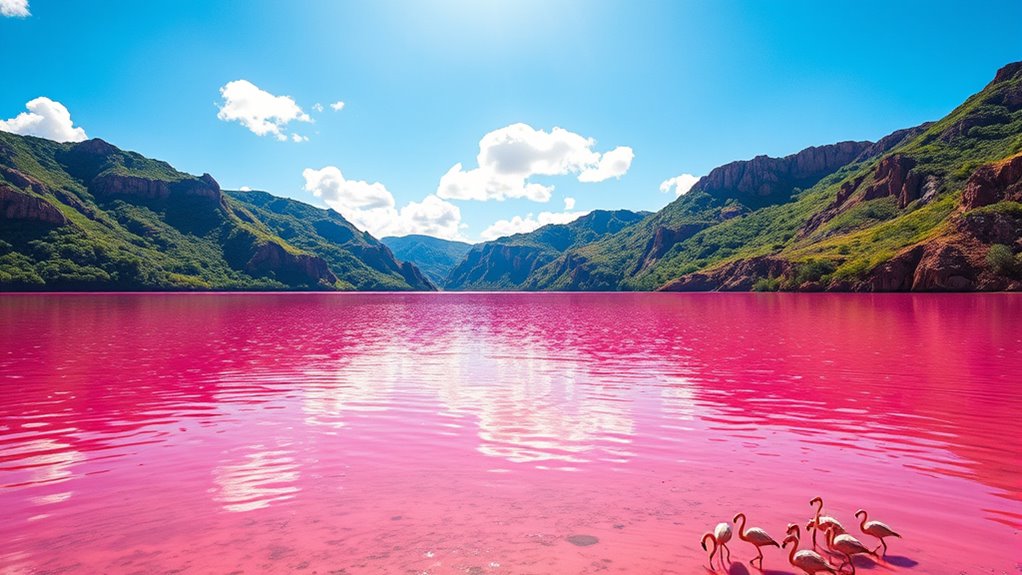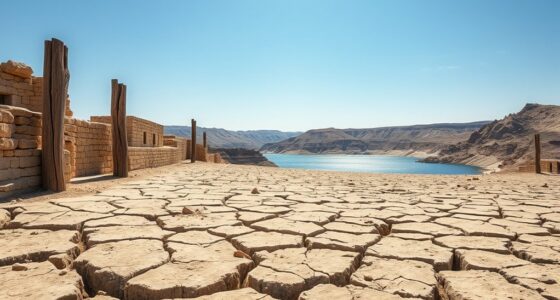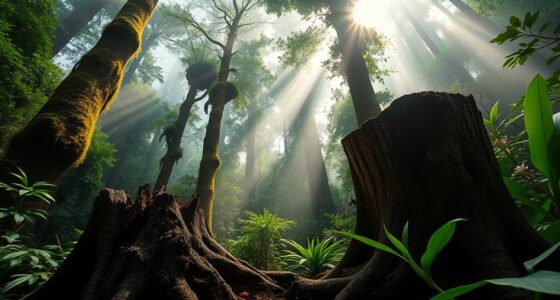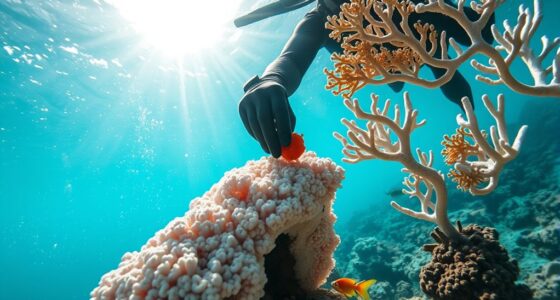Lakes turn pink mainly because of algae blooms, like Dunaliella salina, that produce carotenoid pigments such as beta-carotene, giving the water a vibrant hue. Mineral deposits from underground sources can also intensify the color. These phenomena usually indicate healthy, nutrient-rich ecosystems but can sometimes signal environmental stress or pollution. Understanding why lakes turn pink reveals important clues about local wildlife and ecosystem health—if you want to discover more about what this means for nature, keep exploring.
Key Takeaways
- Pink lakes are caused by algae like Dunaliella salina producing carotenoid pigments, especially beta-carotene.
- Mineral deposits from underground sources can enhance the lake’s pink coloration.
- Such color changes indicate ecological responses to environmental factors like salinity, sunlight, and climate.
- The pink hue signals healthy algae populations, which serve as food for microorganisms and birds, supporting local wildlife.
- Sudden or excessive color shifts may warn of ecological stress, pollution, or harmful algal blooms affecting aquatic ecosystems.

Have you noticed lakes turning a striking shade of pink? It’s a mesmerizing sight that often sparks curiosity and concern. This vivid transformation usually results from natural processes, primarily algae blooms and mineral deposits, both of which play pivotal roles in creating these surreal hues. When certain algae species, like Dunaliella salina, thrive in specific conditions, they produce carotenoid pigments—mainly beta-carotene—that give the water its vibrant pink color. These algae flourish in lakes with high salinity and intense sunlight, conditions that favor their growth over other microorganisms. As they multiply rapidly, the water’s appearance shifts dramatically, turning a bright pink that can be visible from miles away. This phenomenon isn’t just a visual spectacle; it signifies an ecological response to environmental factors, often linked to seasonal changes or climate variations. Color accuracy in natural settings can influence the perception of these lakes’ stunning appearance.
Mineral deposits also contribute considerably to the pink coloration. In some lakes, mineral-rich waters seep from underground sources, bringing with them deposits of salts and other minerals. When these minerals settle at the lake’s surface or interact with algae, they can intensify the pink hue. For example, salt flats and mineral-laden lakes in arid regions often display a stunning pink or reddish tint due to the accumulation of halite, gypsum, or other mineral deposits. These minerals can also influence the water’s salinity and pH, creating conditions that favor certain algae blooms. As the algae produce their pigments and mineral deposits settle, the combined effect amplifies the pink appearance, creating a natural palette that’s both beautiful and complex. Understanding what this means for wildlife depends on the context. In some cases, these pink lakes are part of a healthy, productive ecosystem where algae serve as a crucial food source for microorganisms and birds. However, excessive algae blooms can sometimes indicate nutrient overloads—often from pollution—leading to harmful algal blooms that deplete oxygen levels and threaten fish and other aquatic life. The presence of mineral deposits can also alter habitat conditions, affecting the species that can thrive there. While many wildlife species adapt to these changes, large or sudden shifts in lake coloration can sometimes signal environmental stress or imbalance. If you’re observing these lakes, it’s essential to contemplate both the natural beauty and the ecological implications, recognizing that these phenomena, while stunning, also reflect the health of the surrounding environment.
Frequently Asked Questions
Can Pink Lakes Be Safely Visited by Tourists?
You can generally visit pink lakes safely, but it’s important to consider cultural significance and tourist safety. Some lakes hold special meaning for local communities, so respecting the environment and guidelines is vital. Always follow signage and stay on designated paths to avoid damaging fragile ecosystems. By doing so, you guarantee a safe and respectful experience, enjoying the vibrant beauty while preserving the lake’s natural and cultural value for future visitors.
How Long Do Pink Lakes Typically Stay Vibrant?
Think of lake coloration like a vibrant painting that changes with the seasons. Typically, pink lakes stay vivid for days or weeks, but pigment stability varies due to factors like temperature, salinity, and algae blooms. These conditions influence how long the lake keeps its striking hue. So, if you visit, plan your trip during peak coloration, which often lasts just a few weeks, to see the lake at its most breathtaking.
Do Pink Lakes Occur Naturally or Only Due to Human Activity?
Pink lakes occur naturally through processes like high salinity and algae growth, but human impact can also cause them to turn pink. You should know that natural processes such as mineral deposits and specific microorganisms often create the vibrant color. However, human activities like mining, water diversion, or pollution can increase salinity or introduce substances that enhance the pink hue. So, both natural processes and human impact contribute to the formation of pink lakes.
Are Pink Lakes Harmful to Local Aquatic Life?
Pink lakes aren’t necessarily harmful to aquatic life. The vibrant color results from algae blooms, which thrive due to specific water chemistry conditions. While some algae can produce toxins, many are harmless, and the color change is mainly aesthetic. You should monitor water quality, as shifts in water chemistry could signal potential risks. Overall, pink lakes can be safe, but it’s important to understand the specific algae and conditions involved.
Can Climate Change Cause Lakes to Turn Pink?
Did you know climate change has increased the frequency of algae blooms, which can turn lakes pink? Rising temperatures and altered rainfall patterns boost salt evaporation, creating ideal conditions for certain algae to thrive. This process causes lakes to turn pink, signaling environmental shifts. You should be concerned because these changes threaten aquatic ecosystems, impact local wildlife, and reflect broader climate issues that demand urgent attention and action.
Conclusion
Next time you see a pink lake, remember it’s a sign of vibrant life and delicate balance. Did you know that some of these lakes can change color within hours, reflecting shifts in microbial activity? While they look stunning, these lakes also highlight the fragile ecosystems that depend on their unique conditions. Safeguarding these natural wonders ensures future generations can marvel at their mesmerizing beauty and learn from their ecological significance.









